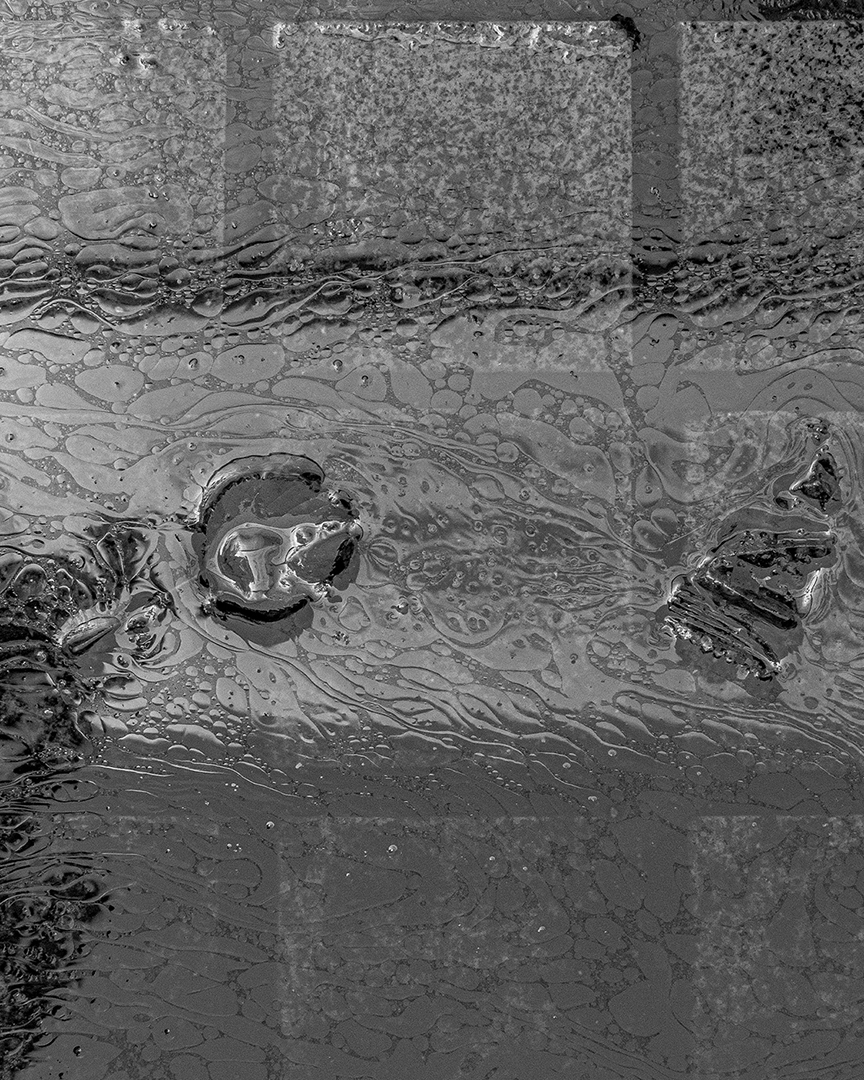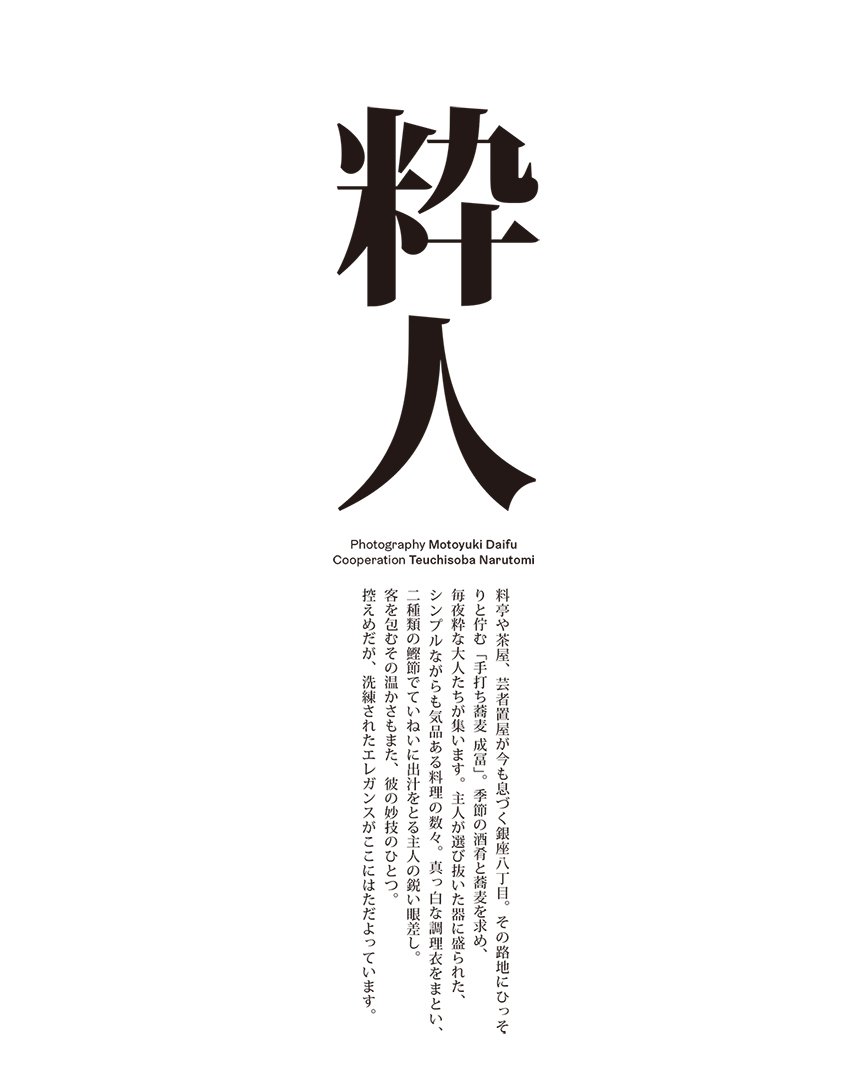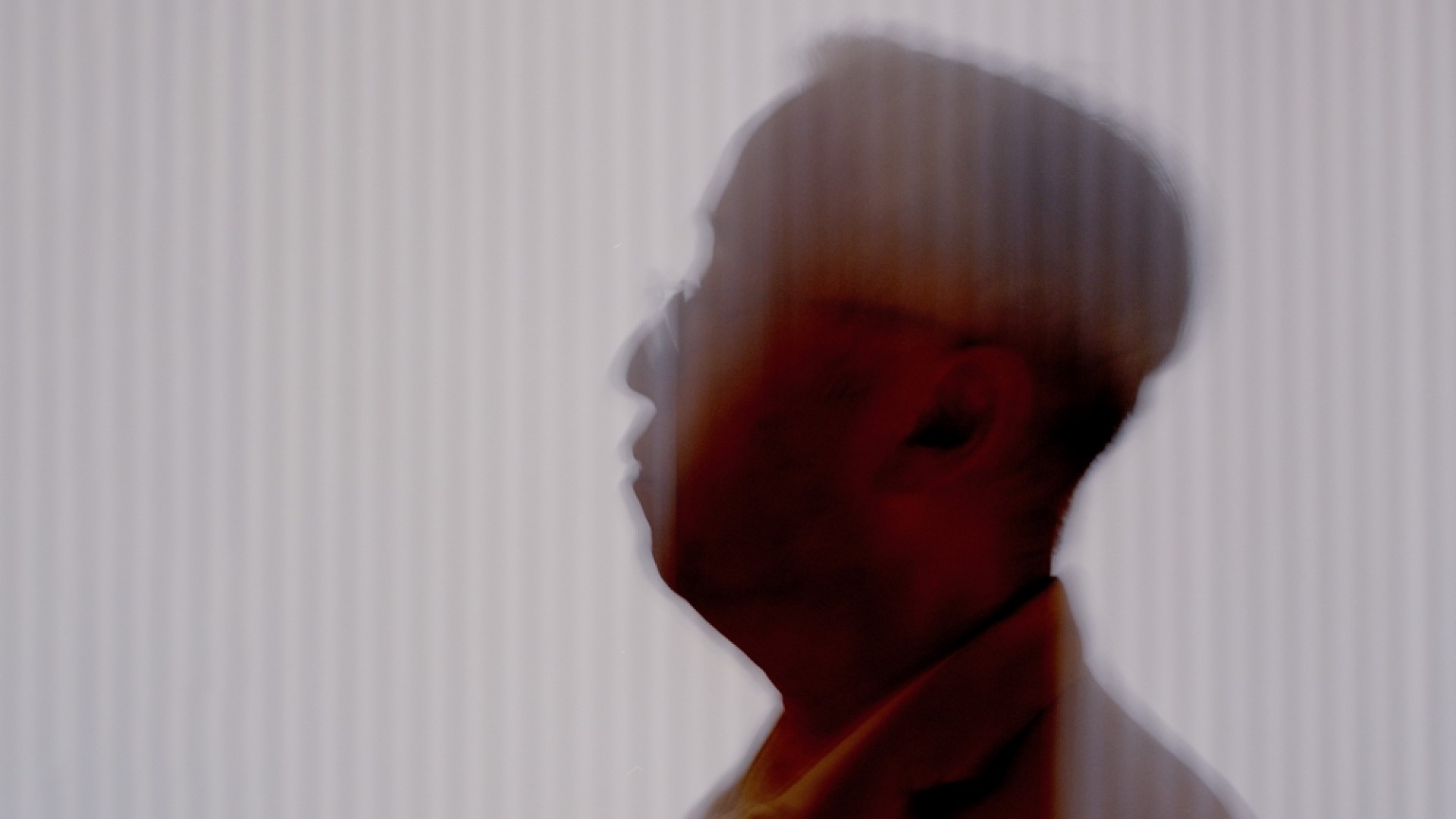
銀座――この魅力的な街は、多くの人々にとって、特別な瞬間や記憶に残る場所となっています。親に手を引かれて足を踏み入れたデパート、マスターのこだわりを感じる喫茶店、初デートで訪れたレストラン。どれもが、この街の独特の雰囲気と結びついています。
連載「銀座・メモワール」では、森岡書店代表、森岡督行さんがナビゲーターとして登場します。多様なゲストが織りなす銀座の豊かな物語を共有し、銀座の多面性とその普遍的な魅力に焦点を当てます。連載を通じて、銀座の隠れた魅力と多彩なストーリーに触れ、新たな価値を一緒に発見しましょう。
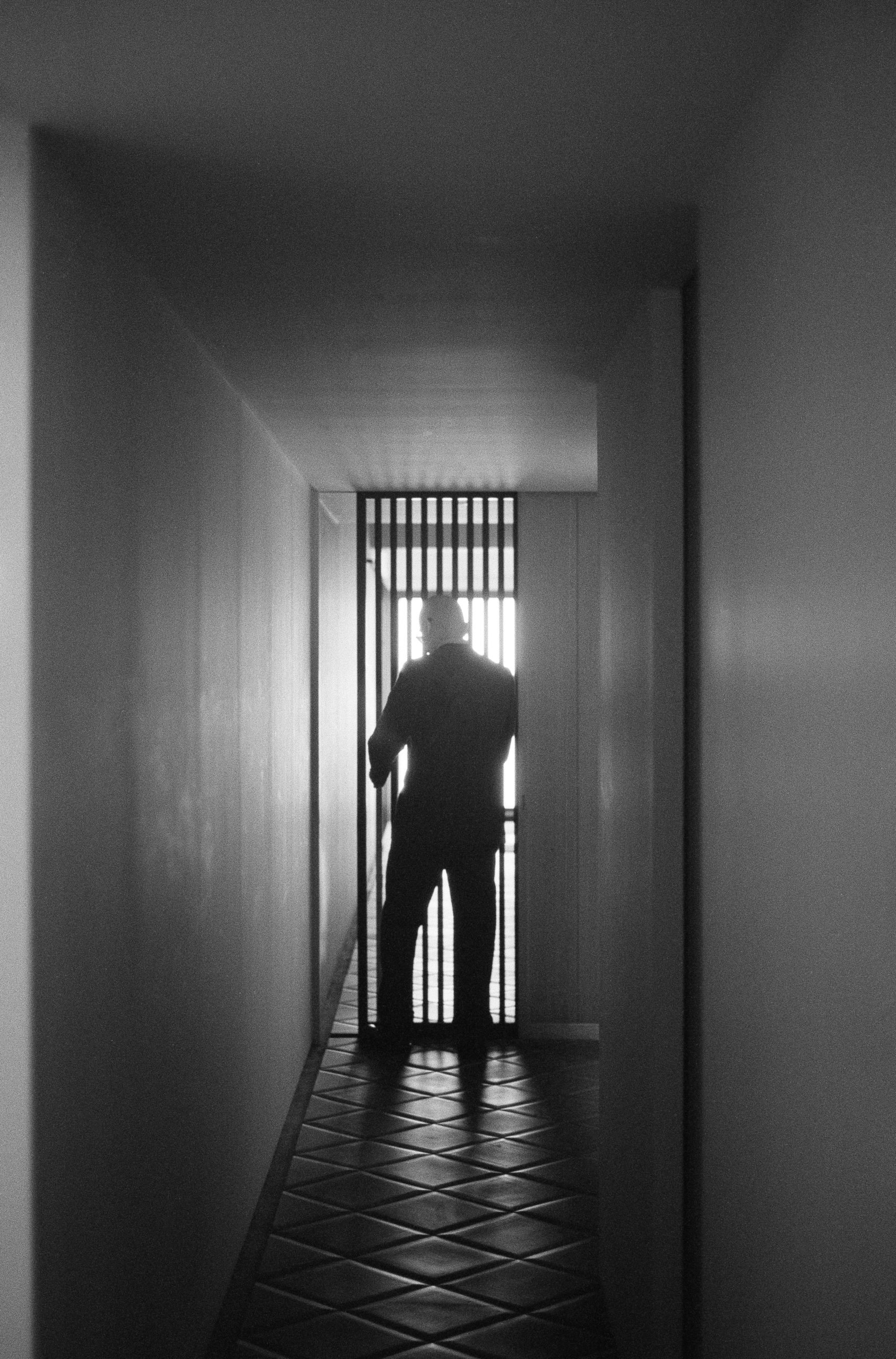
記念すべき連載第1回のゲストは、現代美術作家の杉本博司さんです。2001年にハッセルブラッド賞を受賞した写真のほか、建築や陶芸、茶、古典芸能、書、彫刻など多岐にわたるメディアを用いた活動で知られる杉本さんですが、古美術コレクターとしての顔も持ち合わせています。2008年からは建築家・榊⽥倫之さんとともに設立した設計事務所「新素材研究所」で古代から近世までの素材や工法を研究し、それらの現代における再解釈と再興に取り組んでいます。
そんな「故きをたずねて新しきを知る」杉本さんは、銀座という街の移り変わりをどのように見てきたのでしょうか。運河の匂い、初デートの味、塀越しに眺めた帝国ホテル――幼い頃から両親に連れられて来ていたという銀座と杉本さんとの付き合いは70年以上におよびます。
9月の昼下がり。ギャラリー小柳の奥間で語られた杉本さんのメモワールには、古くて新しい銀座の風景がありました。
銀座の風景を彩ったモダニズム建築
森岡 先日、壹番館洋服店でばったりお会いしましたね。
杉本 壹番館で背広を作るもの同士、一流の紳士として出会えたということですよ。
森岡 俳優の中井貴一さんも壹番館でお洋服を作っていらっしゃるそうですが、中井貴一さんつながりですと、お父様の佐田啓二さんが主演した映画『君の名は』(1953年)で、銀座の数寄屋橋が重要な場面として登場します。
杉本 『君の名は』は子どもの頃にラジオで聴きました。話の内容は理解できていなかったと思いますが、おばさんたちがキャーキャー騒いで聴いていたので。ラジオが始まると、女風呂が空っぽになると言われていた頃ですよ。
森岡 今では埋め立てられて高速道路になってますが、杉本さんは数寄屋橋を実際に見ているんですか。
杉本 よく覚えていますよ。数寄屋橋交差点から日劇(日本劇場)と朝日新聞社ビルが見えました。朝日のビルはなかなか良いデザインでしたね。
森岡 朝日新聞社のビルを設計した建築家の山口文象は、数寄屋橋も設計しているんですよね。あの辺りのイメージは山口文象が作ったと言っても過言ではない。
杉本 山口文象は日本におけるモダニズム建築家の走りですよ。子どもの頃の記憶ですが、朝日新聞社ビルの脇の通りに、トイレットペーパーを100倍にしたような大きなロール紙がザーッと並んでいました。昭和20年代はまだビルのなかにインク工場があって、そこで印刷もしていたんじゃないかな。
森岡 古地図を見ると細川活版所などもあったみたいですし、銀座は“新聞の街”だったんですよね。
杉本 読売新聞の本社も1970年代に移転するまでは銀座3丁目にありましたからね。今も残っている読売会館は村野藤吾の設計ですね。ビル全体が横ストライプで覆われているので、9階建てなのに20階建てであるかのように錯覚する不思議な建物です。ビックカメラとかそごうが入って、ぐちゃぐちゃになっちゃいましたけど、今でも「読売新聞」と書かれた看板が付いていますよ。日比谷ですけど、日生劇場も同じく村野藤吾の設計ですね。あれはすばらしい。
森岡 そうだ、日生劇場! 私も大好きな建物です。
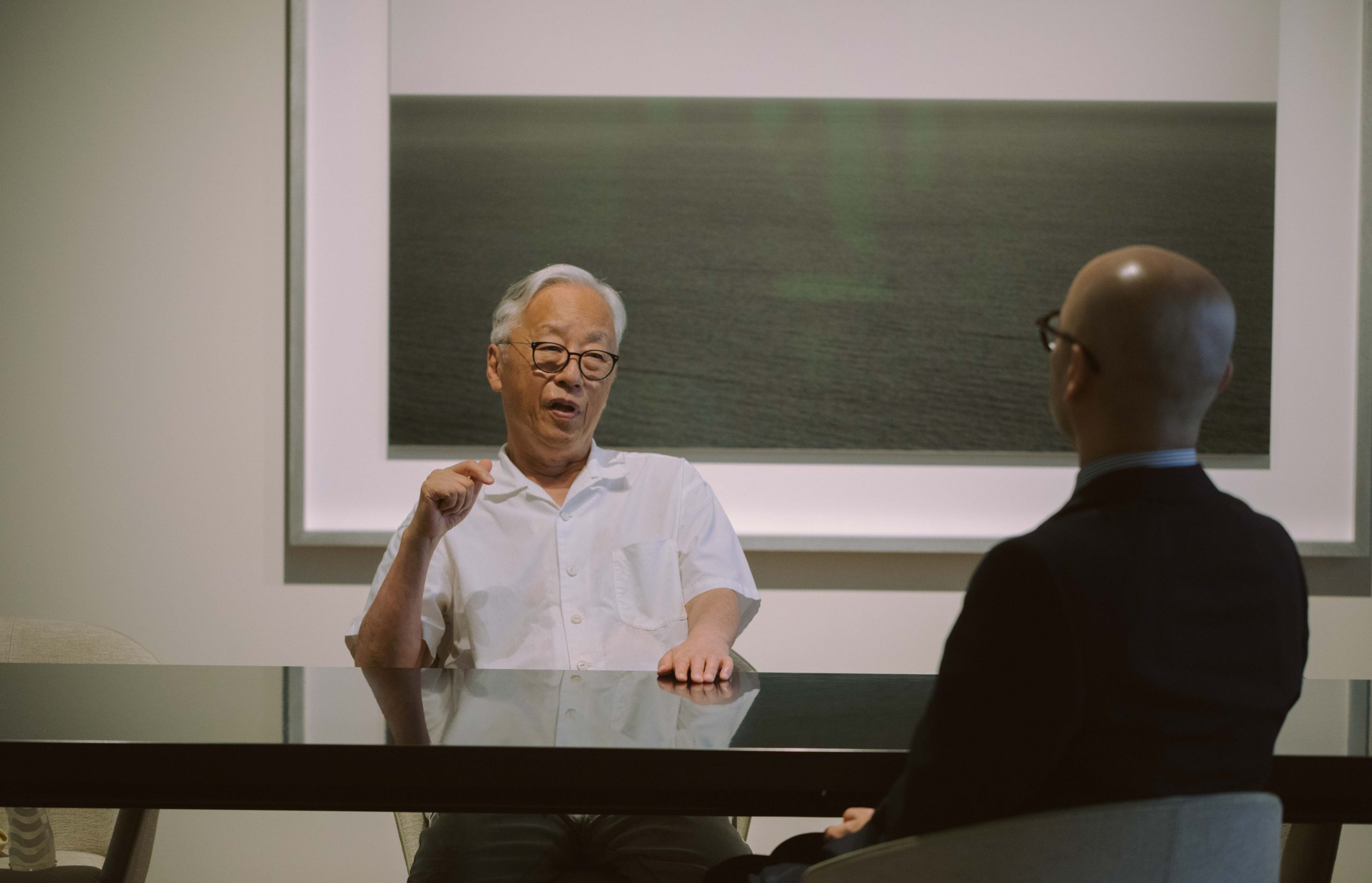
「ニユートーキヨー」から眺めた、運河のきらめき
杉本 それから子どもの頃の記憶といえば、和光も松屋もまだPX(米軍専用の売店)でしたね。日本人お断りで、米軍の関係者でないと入店すらできなかった。サンフランシスコ講和条約が締結され、翌昭和27年に返還されるまではそんな状況でしたよ。
森岡 御徒町ご出身ですが、子どもの頃から銀座に来られていたんですか。
杉本 ええ。僕の実家は、戦前に銀座2丁目で創業した銀座美容商事という美容品を扱う問屋でした。戦火であたり一面が焼けてしまって、戦後は御徒町に移ったのですが、そんな縁もあって、銀座は物心つく以前からよく親に連れてこられましたね。子どもの頃に見た、森永の地球型のネオンも印象に残ってます。数寄屋橋と銀座4丁目のあいだでしたかね。
森岡 ゴジラに踏みつけられるので有名な。銀座には食事に来られていたんですか。
杉本 そうですね。家族でよく「ニユートーキヨー」という高級中華料理店に行きました。母親の友人の洋装店であつらえてもらった、よそ行きの服を着て。店の窓からは眼下を流れる運河が見渡せました。対岸には泰明小学校があって、水面は光が反射していてきれいだったのを覚えています。堀が埋め立てられる前は、銀座はベニスみたいでしたからね。
森岡 水の都だったんですね。
杉本 あたり一帯に水路が通っていましたから。昭和通り側から見た、新橋演舞場が川面に映る光景もよく覚えています。とはいえ、どぶ臭かったですけどね(笑)。
今でも健在。初デートで訪れた「イタリー亭」の味
杉本 そういえば、今日(2023年9月1日)はちょうど関東大震災から100年ですね。
森岡 あの日は帝国ホテルの竣工式だったんですよね。
杉本 周囲の中小ビルが崩落するなかで、帝国ホテルはほぼ無事だった。それで評判をとったみたいですね。
森岡 その後、銀座の復興建築には帝国ホテルに使われたスダレ煉瓦(スクラッチタイル)が多く採用されたようですが、それもその評判あってこそだったんじゃないかなと思います。ちなみにスクラッチタイルを開発した伊那初之烝・長三郎親子は常滑の陶工で、息子の長三郎がINAXの創業者にあたる。
杉本 帝国ホテルを壊しちゃったのはもったいなかったですよね。高度経済成長や64年の東京オリンピックで客室が足りなくなった、ということだと思うんですけど。
森岡 なかに入られた記憶はありますか。
杉本 入ったことはないけど、鉄の塀からよく覗いていましたよ。帝国ホテルの隣にあった映画館街に母親とよく来ていましたから。東宝名人会という落語の公演があったので、父親にも連れて来られましたね。「これが帝国ホテルか」と思ったのを覚えています。
森岡 お父様は噺家でもあったんですよね。
杉本 ええ。三遊亭歌幸という芸名で。父親は家業で成功して、落語界のパトロンをしていたんです。だから、子どもの頃からしょっちゅう寄席の楽屋に出入りしていました。人形町の末廣ですか。講談を聞ける場所もありましたね。
森岡 初めてのデートは、銀座1丁目のイタリー亭だったとか。
杉本 初めてピザを食べたのもイタリー亭でした。大学に入ってからだから、18〜19歳の頃ですね。当時ピザが食べられるお店といえば、イタリー亭と飯倉のニコラス・ピザハウスの2軒くらいしかなかった。ニコラスは力道山とか芸能人が通うようなお店、イタリー亭はカジュアルで入りやすいお店でした。昨日久しぶりにナポリタンを食べに行きましたが、味は当時のままでしたね。日本のナポリタン。地下の内装や赤いタータン柄のテーブルクロスもまったく変わってない。
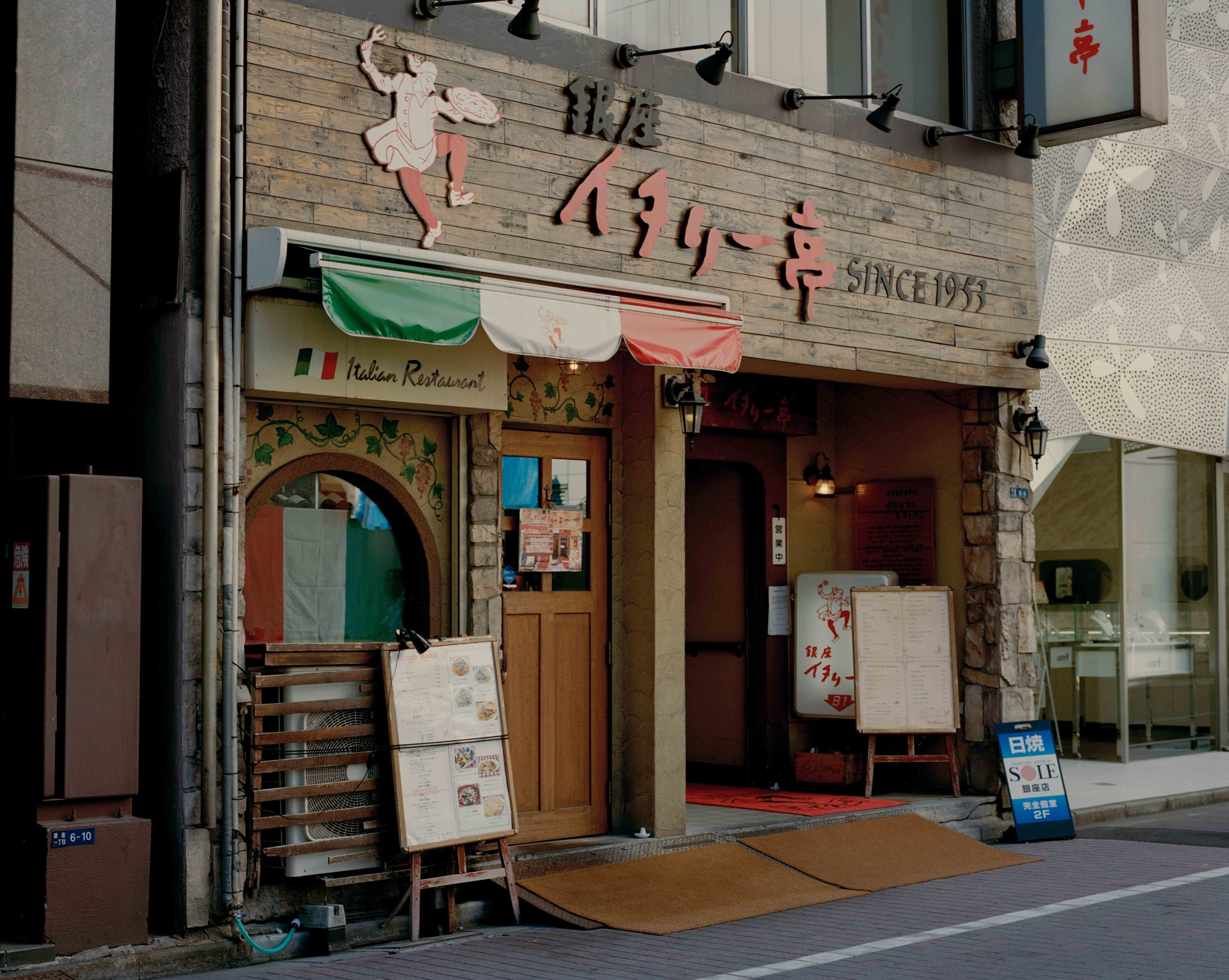
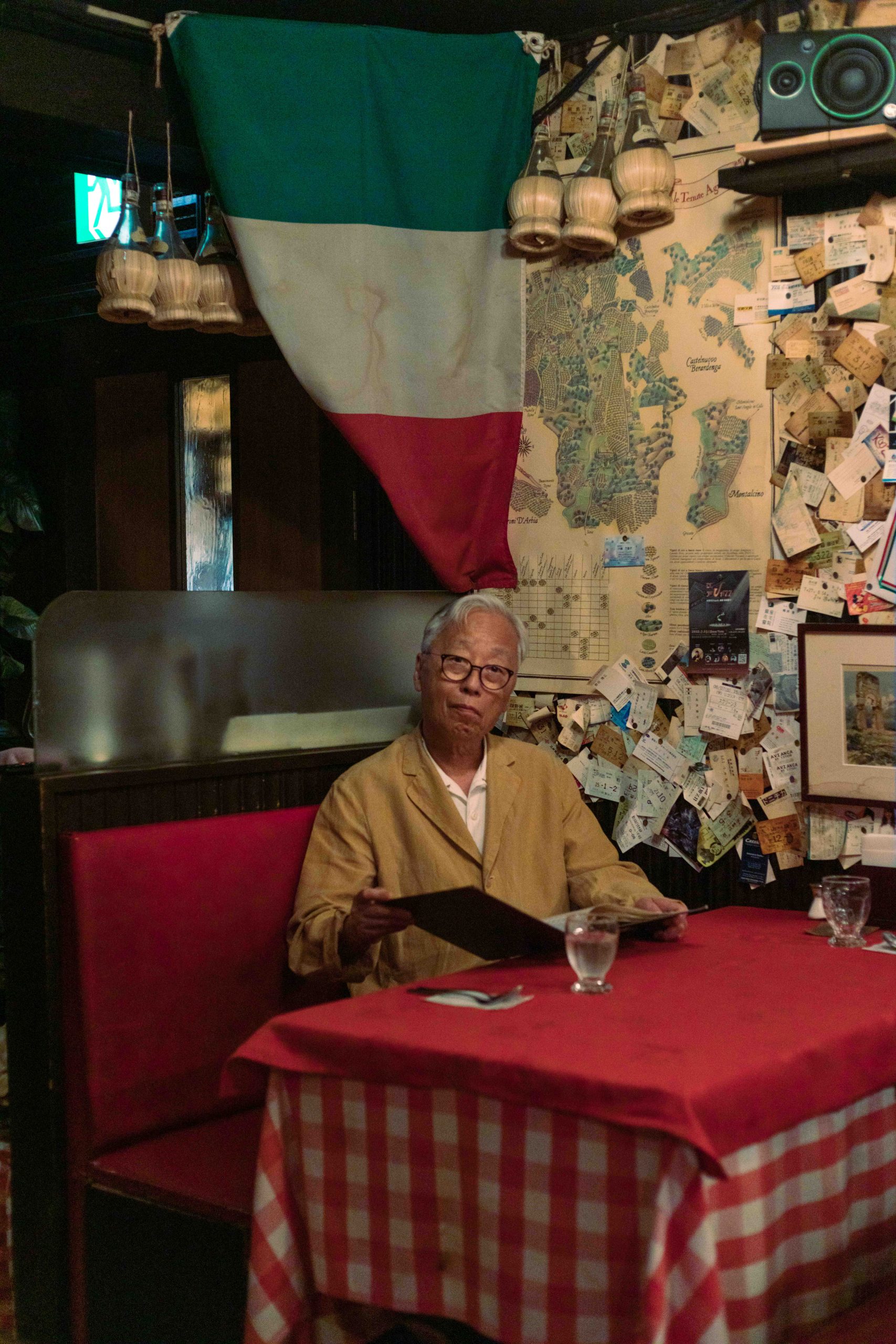
学生運動とアイビールック
森岡 立教大学に通われていたと思いますが、そうなると、池袋から銀座に出ていたわけですね。
杉本 車をもっていたんでね。当時は無料で路上駐車ができましたから(笑)。それこそ、このギャラリー小柳の前に停めていましたよ。
森岡 大学生ということは1968〜1969年あたりですか。学生運動が盛り上がっている時期ですよね。
杉本 1969年に大学紛争が起こって、大学が完全閉鎖しました。1970年も閉鎖されていたので、4年生のときは授業がまったくなかったですね。
森岡 立教大学の経済学部はマルクス主義の牙城だったと思いますが、杉本さんも学生運動に参加されていたんですか。
杉本 大学ではマルクス経済をやっていましたからね。三派(全学連)とか色々集会がありましたけど、僕はべ平連に参加していました。べ平連のヘルメットを被っていると、どこの集会に行ってもゲバ棒で危害を加えられないんですよ(笑)。
森岡 ”なんでも見てやろう”という好奇心があった?
杉本 集会では、なぜ学生が立ち上がる必要があるのかというリーダーの演説があって、世界情勢の分析をするんです。そういうのを聴きたくて、参加していました。時代が大きく動いていましたね。学生運動の裏では、ビートルズをはじめとする若者の新しい文化が台頭していたわけですから。
森岡 60年代は銀座でみゆき族が登場した頃でもあります。杉本さんはみゆき族にも関係していたんですか。
杉本 アイビールックの時代でしたからね。️僕も長髪でしたよ(笑)。VAN派とJUN派があって、僕はどちらかというとJUN派でした。アメリカントラッドなVANに対して、JUNはヨーロッパテイストでより過激な印象で。JUNはみゆき通りにブティックがありましたね。
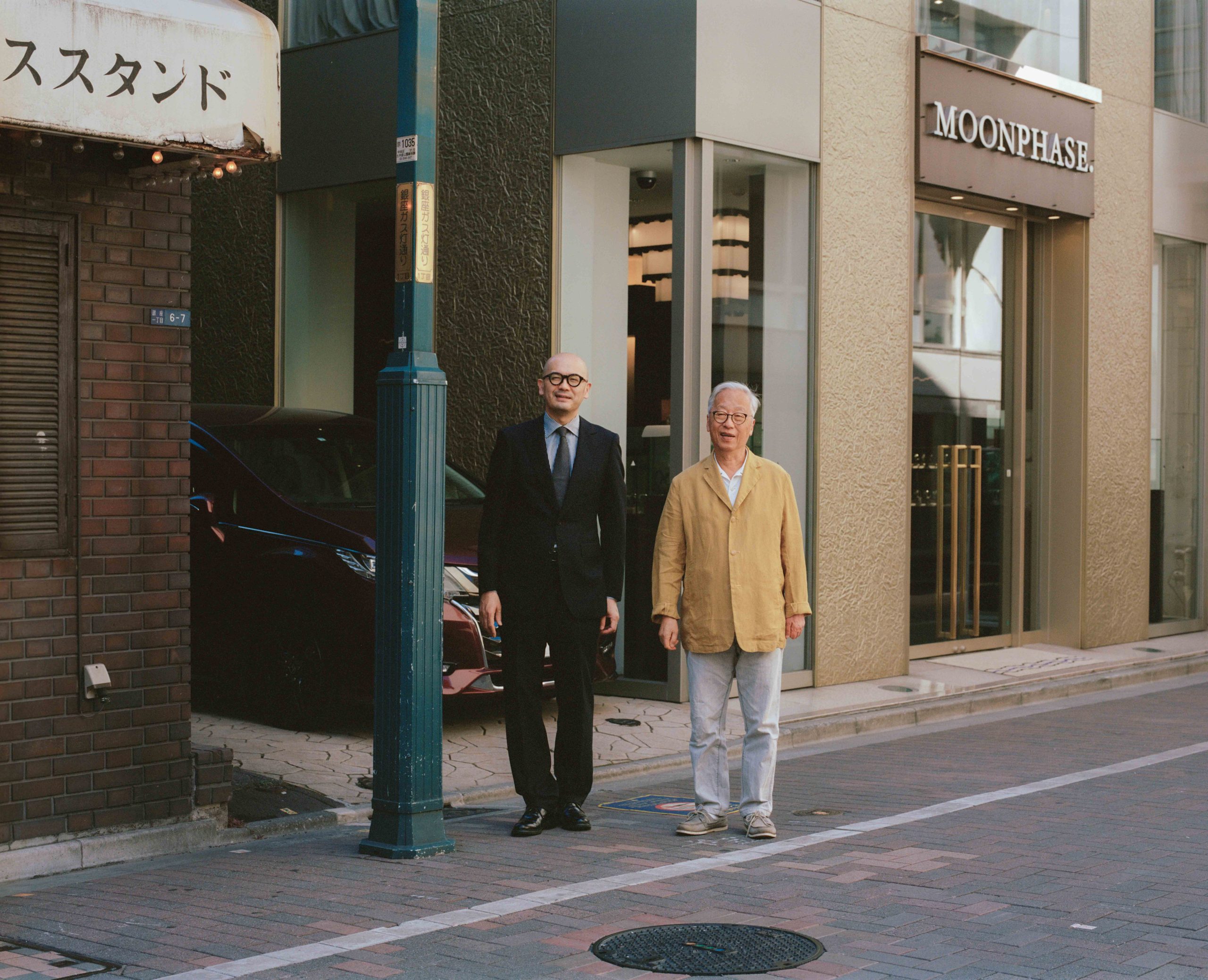
杉本博司
杉本博司の活動分野は、写真、彫刻、インスタレーション、演劇、建築、造園、執筆、料理、と多岐に渡る。杉本のアートは歴史と存在の一過性をテーマとしている。そこには経験主義と形而上学の知見を持って、西洋と東洋との狭間に観念の橋渡しをしようとする意図がある。時間の性質、人間の知覚、意識の起源、といったテーマがそこでは探求される。1948年 東京、御徒町に生まれる。1970年渡米、1974年よりニューヨーク在住、2008年建築設計事務所「新素材研究所」設立。2009年公益財団法人小田原文化財団設立。
受賞:1988年 毎日芸術賞、2001年 ハッセルブラッド国際写真賞、2009年 高松宮殿下記念世界文化賞(絵画部門)、2010年 秋の紫綬褒章、2013年 フランス芸術文化勲章オフィシエ賞、2017年文化功労者。2023年日本芸術院会員に選出。
主な著書:『苔のむすまで』『現な像』『アートの起源』『杉本博司自伝 影老日記』(新潮社)、『空間感』(マガジンハウス)、『趣味と芸術』(ハースト婦人画報社)、『江之浦奇譚』(岩波書店)など森岡督行
1974年山形県生まれ。森岡書店代表。文筆家。『800日間銀座一周』(文春文庫)、『ショートケーキを許す』(雷鳥社)など著書多数。
キュレーターとしても活動し、聖心女子大学と共同した展示シリーズの第二期となる「子どもと放射線」を、2023年10月30日から2024年4月22日まで開催する。
https://www.instagram.com/moriokashoten/?hl=ja平岩壮悟
編集者/ライター
1990年、岐阜県高山市生まれ。フリーランス編集/ライターとして文芸誌、カルチャー誌、ファッション誌に寄稿するほか、オクテイヴィア・E・バトラー『血を分けた子ども』(藤井光訳、河出書房新社)をはじめとした書籍の企画・編集に携わる。訳書にヴァージル・アブロー『ダイアローグ』(アダチプレス)。
https://www.instagram.com/sogohiraiwa/ナタリー・カンタクシーノ
フォトグラファー
スウェーデン・ストックホルム出身のフォトグラファー。東京で日本文化や写真技術を学び、ファッションからドキュメンタリー、ライフスタイルのジャンルで活躍。
https://www.instagram.com/nanorie/
Ginza Memoir #1 Hiroshi Sugimoto, Part 1 “The first date tastes like pizza”
2024.10.17
Text/Sogo Hiraiwa
Photography/Nathalie Cantacuzino
Ginza – This charming city is home to special moments and memories for many people. The department store you walked into with your parents’ help, the coffee shop where you could feel the master’s special attention to detail, the restaurant you visited on your first date. All are tied to the city’s unique atmosphere.
In the series “Ginza Memoir”, Morioka Shoten’s representative, Noriyuki Morioka, will appear as a navigator. A diverse group of guests will share Ginza’s rich stories, highlighting Ginza’s multifaceted nature and its universal appeal. Through this series, let’s come into contact with Ginza’s hidden charms and diverse stories, and discover new values together.
The guest for this memorable first installment of the series is contemporary artist Hiroshi Sugimoto. In addition to his photography, which won the Hasselblad Prize in 2001, Sugimoto is known for his activities in a wide variety of media, including architecture, ceramics, tea, classical performing arts, calligraphy, and sculpture, but he is also an antique collector. . Since 2008, I have been researching materials and construction methods from ancient times to early modern times at the design office “New Materials Research Institute,” which I founded with architect Michiyuki Sakakida, and am working on reinterpreting and reviving them in the modern era.
How has Mr. Sugimoto, who “learns about the new by visiting the past”, observed the changes in the city of Ginza? The smell of the canal, the taste of a first date, the view of the Imperial Hotel through the wall – Mr. Sugimoto’s relationship with Ginza has spanned more than 70 years, having been brought to Ginza by his parents since he was a child.
Late afternoon in September. Mr. Sugimoto’s memoir, which was told in the back room of Gallery Koyanagi, included old and new scenes of Ginza.
Modernist architecture adorns the landscape of Ginza
Morioka: We ran into each other at Ichibankan clothing store the other day.
Sugimoto: The people who make suits at Ichibankan were able to meet each other as first-class gentlemen.
Morioka: I heard that actor Kiichi Nakai also makes clothes at Ichibankan.As for his connection to Kiichi Nakai, his father, Keiji Sada, starred in the movie “Your Name” (1953), which was produced in Ginza. Sukiyabashi appears as an important scene.
Sugimoto: I heard “Your Name” on the radio when I was a child. I don’t think I understood what was being said, but the ladies were making a lot of noise as I listened. There was a time when it was said that the women’s baths would be empty when the radio started.
Morioka: Now that it has been reclaimed and turned into an expressway, Mr. Sugimoto, have you actually seen Sukiyabashi?
Sugimoto: I remember it well. I could see the Nichigeki (Japanese Theater) and the Asahi Shimbun building from the Sukiyabashi intersection. The Asahi building had a very good design.
Morioka: The architect who designed the Asahi Shimbun building, Bunzo Yamaguchi, also designed Sukiyabashi Bridge. It would be no exaggeration to say that that image was created by Bunzo Yamaguchi.
Sugimoto: Bunzo Yamaguchi is the leading modernist architect in Japan. I remember when I was a child, the street next to the Asahi Shimbun building was lined with large rolls of paper that looked like 100 times the size of toilet paper. In the 1940s, there was still an ink factory in the building, and I think printing was done there as well.
Morioka: Looking at old maps, it seems that Hosokawa Letterpress Co., Ltd. was also there, and Ginza was a “newspaper town.”
Sugimoto: The Yomiuri Shimbun headquarters was also located in Ginza 3-chome until it was moved in the 1970s. The Yomiuri Hall, which still stands today, was designed by Togo Murano. The entire building is covered with horizontal stripes, so it is a mysterious building that gives the illusion of being 20 stories even though it is 9 stories high. Bic Camera and Sogo moved in, and it became a mess, but it still has a sign that says “Yomiuri Shimbun.” Although it’s Hibiya, the Nissay Theater was also designed by Togo Murano. That’s wonderful.
Morioka: That’s right, Nissay Theater! It’s my favorite building too.
The glittering canal seen from “New Tokyo”
Sugimoto: Also, when I think about my childhood memories, both Wako and Matsuya were still PX stores (stores exclusively for the U.S. military). Japanese people were not allowed, and unless you were a member of the U.S. military, you could not even enter the store. This was the situation until the San Francisco Peace Treaty was signed and the island was returned the following year in 1951.
Morioka: You are from Okachimachi, but have you been coming to Ginza since you were a child?
Sugimoto: Yes. My parents’ home was a beauty products wholesaler called Ginza Beauty Shoji, which was founded in Ginza 2-chome before the war. The whole area was burnt down by the war, so we moved to Okachimachi after the war, but because of that connection, my parents often brought me to Ginza from before I could remember. Morinaga’s globe-shaped neon lights that I saw when I was a child also left an impression on me. I think it was between Sukiyabashi and Ginza 4-chome.
Morioka: Famous because it gets trampled by Godzilla. Did you come to Ginza for dinner?
Sugimoto: That’s right. My family and I often went to a high-end Chinese restaurant called New Tokyo. I was wearing clothes from outside that my mother’s friend’s clothing store had made for me. The shop window overlooked the canal flowing below. There was Taimei Elementary School on the opposite bank, and I remember that the water surface was beautiful with the light reflecting off of it. Before the moat was reclaimed, Ginza was like Venice.
Morioka: It was a city of water.
Sugimoto: There were waterways running through the area. I also remember well the sight of the Shinbashi Enbujo reflected in the river from the Showa-dori side. However, it did stink.lol
Still alive and well. The taste of “Italie-tei” visited on the first date
Sugimoto: By the way, today (September 1, 2023) is exactly 100 years since the Great Kanto Earthquake.
Morioka: That day was the completion ceremony for the Imperial Hotel, right?
Sugimoto: While the surrounding small and medium-sized buildings collapsed, the Imperial Hotel was largely unscathed. That seems to have earned it a reputation.
Morioka: Afterwards, it seems that the same scratch tiles used in the Imperial Hotel were often used in Ginza’s reconstruction architecture, and I think that was due to its reputation. Incidentally, the father and son, Ina Hatsunoho and Chozaburo, who developed the scratch tile, are potters in Tokoname, and their son Chozaburo is the founder of INAX.
Sugimoto: It was a waste to destroy the Imperial Hotel. I think it was because of the rapid economic growth and the 1964 Tokyo Olympics that there was a shortage of guest rooms.
Morioka: Do you have any recollection of being taken inside?
Sugimoto: I’ve never been inside, but I often peeked through the iron fence. I often went to the movie theater district next to the Imperial Hotel with my mother. There was a rakugo performance called Toho Meijinkai, so my father also brought me there. I remember thinking, “This is the Imperial Hotel.”
Morioka: Your father was also a storyteller.
Sugimoto: Yes. Under the stage name Kako Sanyutei. My father was successful in the family business and was a patron of the rakugo world. So, ever since I was a child, I was often in the dressing room of vaudeville shows. Is this Suehiro from Ningyocho? There was also a place where you could listen to lectures.
Morioka: Their first date was at Italy-tei in Ginza 1-chome.
Sugimoto: The first time I ate pizza was at Italy-tei. It was after I entered university, so I was around 18 or 19 years old. At that time, there were only two places where you could eat pizza: Italy-tei and Nicholas Pizza House in Iikura. Nicholas was a restaurant like Rikidozan that celebrities frequented, and Italy-tei was a casual and easy-to-enter restaurant. I went to eat Neapolitan yesterday for the first time in a while, and the taste was still the same. Japanese Neapolitan. The interior of the basement and the red tartan tablecloths haven’t changed at all.
Student movement and ivy look
Morioka: I think you attended Rikkyo University, so you moved from Ikebukuro to Ginza.
Sugimoto: He had a car. Back then, you could park on the street for free (lol). That’s exactly what was parked in front of Gallery Koyanagi.
Morioka: You were a university student around 1968-1969? This is a time when student movements are in full swing.
Sugimoto: In 1969, a university dispute broke out and the university closed completely. The school was closed in 1970, so I didn’t have any classes when I was in fourth grade.
Morioka: I believe that the Faculty of Economics at Rikkyo University was a stronghold of Marxism, but are you also involved in the student movement, Mr. Sugimoto?
Sugimoto: I studied Marxian economics at university. There were various meetings such as Sanha (Zengakuren), but I participated in Beheiren. If you’re wearing a Beheiren helmet, you won’t be able to pose any danger with a stick even if you go to any gathering. lol
Morioka: Did you have a curiosity that made you want to see everything?
Sugimoto: At the assembly, leaders give speeches about why students need to stand up and analyze the world situation. I wanted to hear that kind of thing, so I participated. Times were changing a lot. Behind the scenes of the student movement, a new culture of young people was emerging, including the Beatles.
Morioka: The 1960s was also the time when the Miyuki clan appeared in Ginza. Was Mr. Sugimoto also related to the Miyuki clan?
Sugimoto: It was the era of the ivy look. ️I also had long hair. lol There are VAN fans and JUN fans, and I was more of a JUN fan. In contrast to the American traditional VAN, JUN has a more radical impression with a European taste. JUN had a boutique on Miyuki Street.
Hiroshi Sugimto
Hiroshi Sugimoto’s activities span a wide range of fields, including photography, sculpture, installation, theater, architecture, landscaping, writing, and cooking. Sugimoto’s art focuses on history and the transience of existence. His intention is to use his knowledge of empiricism and metaphysics to bridge the gap between the West and the East. Themes such as the nature of time, human perception, and the origins of consciousness are explored. Born in Okachimachi, Tokyo in 1948. Moved to the United States in 1970, lived in New York since 1974, and established the architectural design office “New Materials Research Institute” in 2008. In 2009, the Odawara Cultural Foundation was established.
Awards: 1988 Mainichi Art Award, 2001 Hasselblad International Photography Award, 2009 Prince Takamatsu Memorial World Cultural Award (Painting Category), 2010 Autumn Medal with Purple Ribbon, 2013 Official Award of the French Order of Arts and Letters, 2017 Person of Cultural Merit. Selected as a member of the Japan Art Academy in 2023.
Major books: “Moss Musume,” “Gennazo,” “The Origin of Art,” “Hiroshi Sugimoto’s Autobiography: Kagero Nikki” (Shinchosha), “Kekkankan” (Magazine House), “Hobby and Art” (Hearst Fujin Painting Hosha), “Enoura Kitan” (Iwanami Shoten), etc.Yoshiyuki Morioka
Born in Yamagata Prefecture in 1974. Representative of Morioka Shoten. Writer. He has written many books, including “800 Days Around Ginza” (Bunshun Bunko) and “I Forgive Shortcakes” (Raichousha).
She also works as a curator and will hold the second phase of the exhibition series, “Children and Radiation,” in collaboration with University of the Sacred Heart, from October 30, 2023 to April 22, 2024.
https://www.instagram.com/moriokashoten/?hl=jaSogo Hiraiwa
Editor/Writer
Born in 1990 in Takayama City, Gifu Prefecture. In addition to contributing to literary, culture, and fashion magazines as a freelance editor/writer, he also plans and edits books such as Octavia E. Butler’s “Children of Blood” (translated by Hikaru Fujii, published by Kawade Shobo Shinsha). Involved in Translated by Virgil Abloh “Dialogue” (Adachi Press)
https://www.instagram.com/sogohiraiwa/Nathalie Cantacuzino
Photographer from Stockholm, Sweden. Studied Japanese culture and photography techniques in Tokyo, and is active in genres ranging from fashion to documentary and lifestyle.
https://www.instagram.com/nanorie/

